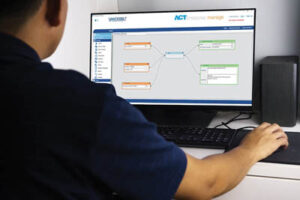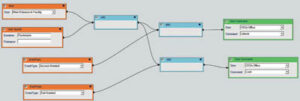The delivery of smart solutions has been made easier for many integrators and installers via the implementation of ‘cause and effect’ logical programming. This allows a system to automatically trigger actions in response to user-defined events, system or site status changes, or even transactional or operational data. As a result, the creation of a bespoke and flexible system delivering added value for the customer is made simpler. The approach is popular in video surveillance applications and has increased traction in the site protection market. Now Vanderbilt is bringing it to access control solutions via its ACT Enterprise software.
The security market has traditionally focused on alarms and responses. An event occurs, is detected, and the result is an alarm activation of some type: an audible or visual alert, a message passed to an ARC or control room, a camera recorded or a door locked. These simple relationship-based triggers and responses can be effective, and are still widely used. However, they are somewhat restricted in terms of what can and cannot be achieved.
 Today’s advanced solutions are capable of so much more that creating alarms when an exception occurs, and it is this depth of flexibility that allows system integrators and security installers to add value for their customers.
Today’s advanced solutions are capable of so much more that creating alarms when an exception occurs, and it is this depth of flexibility that allows system integrators and security installers to add value for their customers.
While security is important for many sites, the perceived value of a security system is enhanced when it delivers additional benefits. These might be proactive security, enhanced site safety, enforcement of compliance issues, personnel and asset management, business efficiencies or site management automations.
When these benefits are tied into the security solution, and can be delivered with resilience, they serve to enhance the overall value proposition of the security solution.
Logical programming
Logical programming is not new. It is known by many different names, dependent upon the sector that is using the approach. Some of various descriptors include AND/OR Logic, Boolean Logic, ‘if this, then that’ (not to be confused with the IFTTT on-line service), recipes, cause and effect relationships and commonly in the security sector, Rules.
 Rules allow alarm handling and event management to be enhanced. While offering significantly increased flexibility over typical security-based I/Os, the logical approach of Rules Mapping is based upon a simple concept: the value of variables must be either ‘True’ or ‘False’.
Rules allow alarm handling and event management to be enhanced. While offering significantly increased flexibility over typical security-based I/Os, the logical approach of Rules Mapping is based upon a simple concept: the value of variables must be either ‘True’ or ‘False’.
Whilst having only two possible values might seem a limitation, what gives Rules a significant degree of flexibility is the inclusion of ‘Operations’. The most basic Operations are AND, OR and NOT, but there are many others. These are used to either link or filter criteria.
In security systems, the Operations are pertinent to the tasks associated with the system. These can be used to create Rules which vary from the simple and basic to the complex, dependent upon site requirements. This means that Rules can use multiple criteria, and filtering of trigger events is also possible.
That this approach is used in all computer programming languages underlines its inherent flexibility. However, some believe that because it is key to computer programming languages, it must be complicated. Thankfully, security manufacturers use basic interfaces, consisting of drop-down menus, drag and drop elements and smart GUIs, to make things simple and intuitive for integrators and installers. This ensures that advanced flexibility is easy and fast to configure, creating bespoke systems that meet end users’ needs. In access control solutions, Rules allow a variety of data sources to be used to create advanced features, without a need for writing Macros or advanced programming scripts.
ACT Enterprise Rules Mapping
The ACT access control solution from Vanderbilt has been designed to deliver a host of advanced features that meet and exceed end user expectations. For the integrator and installer, the manufacturer has also ensured the solutions are simple to install and maintain, regardless of an engineer’s access control experience.
Because Vanderbilt sees it as critical the solution is fast to install and straightforward to configure, it was important when the Rules Mapping feature was introduced to the ACT Enterprise software that integrators and installers could deliver the benefits to their customers without spending additional time setting the system up. It was also vital that additional skills, such as writing complex code, were not required to enjoy the flexibility on offer.
As a result, Rules Mapping is a simple ‘point-and-click’ method of establishing criteria which, when met, instigate a series of actions. It is configured via a basic drag-and-drop interface, which allows the use of triggers such as system input and output changes, access control transactions and system status conditions, as well as triggers from other integrated system such as intrusion alarm events.
Rules can be established for security purposes (if an entry door is forced while specified users are not on site, instigate a lockdown in certain departments and notify the security team) through to business efficiencies (if all IT team members have left for the night, disable power to the department).








